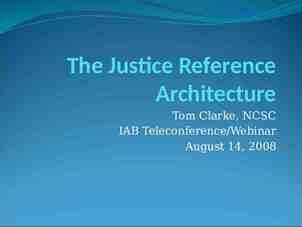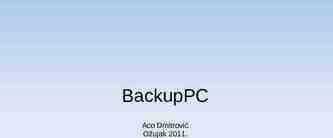CSCI 4717/5717 Computer Architecture Topic: Buses Reading:
54 Slides551.50 KB
CSCI 4717/5717 Computer Architecture Topic: Buses Reading: Stallings, Sections 3.4, 3.5, and 7.7 CSCI 4717 – Computer Architecture Buses – Page 1
Buses – Common Characteristics Multiple devices communicating over a single set of wires Only one device can talk at a time or the message is garbled Each line or wire of a bus can at any one time contain a single binary digit. Over time, however, a sequence of binary digits may be transferred These lines may and often do send information in parallel A computer system may contain a number of different buses CSCI 4717 – Computer Architecture Buses – Page 2
Buses – Structure Serial versus parallel Around 50-100 lines although it's possible to have as few as 3 or 4 Lines can be classified into one of four groups – Data lines – Address Lines – Control Lines – Power CSCI 4717 – Computer Architecture Buses – Page 3
Buses – Structure (continued) Bus lines (parallel) – – – – Data Address Control Power Bus lines (serial) – Data, address, and control are sequentially sent down single wire – There may be additional control lines – Power CSCI 4717 – Computer Architecture Buses – Page 4
Buses – Structure (continued) Data Lines – Passes data back and forth – Number of lines represents width Address lines – Designates location of source or destination – Width of address bus specifies maximum memory capacity – High order selects module and low order selects a location within the module CSCI 4717 – Computer Architecture Buses – Page 5
Bus Structure – Control lines Because multiple devices communicate on a line, control is needed Timing Typical lines include: – – – – – – – – – Memory Read or Write I/O Read or Write Transfer ACK Bus request Bus grant Interrupt request Interrupt acknowledgement Clock Reset CSCI 4717 – Computer Architecture Buses – Page 6
Operation – Sending Data Obtain the use of the bus Transfer the data via the bus Possible acknowledgement CSCI 4717 – Computer Architecture Buses – Page 7
Operation – Requesting Data Obtain the use of the bus Transfer the data request via the bus Wait for other module to send data Possible acknowledgement CSCI 4717 – Computer Architecture Buses – Page 8
Classic Bus Arrangement All components attached to bus (STD bus) Due to Moore's law, more and more functionality exists on a single board, so major components are now on same board or even the same chip CSCI 4717 – Computer Architecture Buses – Page 9
Physical Implementations Parallel lines on circuit boards (ISA or PCI) Ribbon cables (IDE) CSCI 4717 – Computer Architecture Buses – Page 10
Physical Implementations (continued) Strip connectors on mother boards (PC104) External cabling (USB or Firewire) CSCI 4717 – Computer Architecture Buses – Page 11
Single Bus Problems Lots of devices on one bus leads to: Physically long buses – Propagation delays – Long data paths mean that coordination of bus use can adversely affect performance – Reflections/termination problems Aggregate data transfer approaches bus capacity Slower devices dictate the maximum bus speed CSCI 4717 – Computer Architecture Buses – Page 12
Multiple Buses Most systems use multiple buses to overcome these problems Requires bridge to buffer (FIFO) data due to differences in bus speeds Sometimes I/O devices also contain buffering (FIFO) CSCI 4717 – Computer Architecture Buses – Page 13
Multiple Buses – Benefits Isolate processor-to-memory traffic from I/O traffic Support wider variety of interfaces Processor has bus that connects as direct interface to chip, then an expansion bus interface interfaces it to external devices (ISA) Cache (if it exists) may act as the interface to system bus CSCI 4717 – Computer Architecture Buses – Page 14
Expansion Bus Example CSCI 4717 – Computer Architecture Buses – Page 15
Mezzanine Approach Differences in I/O speeds demands separating devices. Separate items that are high-speed and those that are not An additional high-speed bus is added to communicate with the faster devices and also the slower expansion bus Advantage is that high-speed devices are brought closer to processor CSCI 4717 – Computer Architecture Buses – Page 16
Mezzanine Approach (continued) CSCI 4717 – Computer Architecture Buses – Page 17
Pentium Example (Source: http://www.amd.com/us-en/assets/content type/white papers and tec CSCI 4717 – Computer Architectureh docs/21644.pdf) Buses – Page 18
Bus Types Dedicated vs. Time Multiplexed Dedicated – Separate data & address lines Time multiplexed – Shared lines – Address valid or data valid control line – Advantage - fewer lines – Disadvantages More complex control Degradation of performance CSCI 4717 – Computer Architecture Buses – Page 19
Bus Types Physical Dedication – Physically separating buses and controlling them with a "channel changer“ – Advantages – faster – Disadvantages – physically larger CSCI 4717 – Computer Architecture Buses – Page 20
Bus Arbitration Listening to the bus is not usually a problem Talking on the bus is a problem – need arbitration to allow more than one module to control the bus at one time Arbitration may be centralised or distributed CSCI 4717 – Computer Architecture Buses – Page 21
Centralised vs. Distributed Arbitration Centralised Arbitration – Single hardware device controlling bus access – Bus Controller/Arbiter – May be part of CPU or separate Distributed Arbitration – Each module may claim the bus – Access control logic is on all modules – Modules work together to control bus CSCI 4717 – Computer Architecture Buses – Page 22
Bus Timing Co-ordination of events on bus Synchronous – controlled by a clock Asynchronous – timing is handled by welldefined specifications, i.e., a response is delivered within a specified time after a request CSCI 4717 – Computer Architecture Buses – Page 23
Synchronous Bus Timing Events determined by clock signals Control Bus includes clock line A single 1-0 cycle is a bus cycle All devices can read clock line Usually sync on leading/rising edge Usually a single cycle for an event Analogy – Orchestra conductor with baton Usually stricter in terms of its timing requirements CSCI 4717 – Computer Architecture Buses – Page 24
Synchronous Bus Timing CSCI 4717 – Computer Architecture Buses – Page 25
Asynchronous Timing Devices must have certain tolerances to provide responses to signal stimuli More flexible allowing slower devices to communicate on same bus with faster devices. Performance of faster devices, however, is limited to speed of bus CSCI 4717 – Computer Architecture Buses – Page 26
Asynchronous Timing – Read CSCI 4717 – Computer Architecture Buses – Page 27
Asynchronous Timing – Write CSCI 4717 – Computer Architecture Buses – Page 28
Bus Width Wider the bus the better the data transfer rate or the wider the addressable memory space Serial “width” is determined by length/duration of frame CSCI 4717 – Computer Architecture Buses – Page 29
Peripheral Component Interconnection (PCI) Bus Brief history Original PC came out with 8-bit ISA bus which was slow, but had enormous amount of existing equipment. For AT, IBM expanded ISA bus to 16-bit by adding connector Many PC board manufacturers started making higher speed, proprietary buses Intel released the patents to its PCI and this soon took over as the standard CSCI 4717 – Computer Architecture Buses – Page 30
PCI Bus (continued) Brief list of PCI 2.2 characteristics General purpose Mezzanine or peripheral bus Supports single- and multi-processor architectures 32 or 64 bit – multiplexed address and data Synchronous timing Centralized arbitration (requires bus controller) 49 mandatory lines (see Table 3.3) CSCI 4717 – Computer Architecture Buses – Page 31
Required PCI Bus Lines (Table 3.3) Systems lines – clock and reset Address & Data – 32 time multiplexed lines for address/data – Parity lines Interface Control – Hand shaking lines between bus controller and devices – Selects devices – Allows devices to indicates when they are ready CSCI 4717 – Computer Architecture Buses – Page 32
Required PCI Bus Lines (continued) Arbitration – Not shared – Direct connection to PCI bus arbiter Error lines – parity and critical/system CSCI 4717 – Computer Architecture Buses – Page 33
Optional PCI Bus Lines There are 51 optional PCI 2.2 bus lines Interrupt lines – Not shared – Multiple lines for multiple interrupts on a single device Cache support 64-bit Bus Extension – Additional 32 lines – Time multiplexed – 2 lines to enable devices to agree to use 64-bit transfer JTAG/Boundary Scan – For testing procedures CSCI 4717 – Computer Architecture Buses – Page 34
PCI Commands Transaction between initiator (master) and target Master claims bus During address phase of write, 4 C/BE lines signal the transaction type One or more data phases CSCI 4717 – Computer Architecture Buses – Page 35
PCI Transaction Types Interrupt acknowledge – prompts identification from interrupting device Special cycle – message broadcast I/O read – read to I/O address space I/O write – write to I/O address space Memory read – 1 or 2 data transfer cycles Memory read line – 3 to 12 data transfer cycles Memory read multiple – more than 12 data transfers CSCI 4717 – Computer Architecture Buses – Page 36
PCI Transaction Types (continued) Memory write – writing 1 or more cycles to memory Memory write and invalidate – writing 1 or more cycles to memory allowing for cache write-back policy Configuration read – reading PCI device's configuration (up to 256 configuration registers per device) Configuration write – writing PCI device's configuration (up to 256 configuration registers per device) Dual address cycle – indication of 64-bit addressing on 32 bit lines CSCI 4717 – Computer Architecture Buses – Page 37
PCI Read Timing Diagram CSCI 4717 – Computer Architecture Buses – Page 38
PCI Bus Arbiter CSCI 4717 – Computer Architecture Buses – Page 39
PCI Bus Arbitration Between Two Masters CSCI 4717 – Computer Architecture Buses – Page 40
Higher Performance External Buses Historically, parallel has been used for high speed peripherals (e.g., SCSI, parallel port zip drives rather than serial port). High speed serial, however, has begun to replace this need Serial communication also used to be restricted to point-to-point communications. Now there's an increasing prevalence of multipoint CSCI 4717 – Computer Architecture Buses – Page 41
IEEE 1394 FireWire Inexpensive alternative needed for SCSI High performance serial bus Serial implies cheaper cabling (fewer wires, less shielding, less synchronization) Small connectors for smaller devices Fast Low cost Easy to implement Also being used in digital cameras, VCRs and TVs CSCI 4717 – Computer Architecture Buses – Page 42
FireWire Configuration Daisy chain/tree structure (Mac O/S Help indicates that daisy chain is preference for up to 16 devices) Up to 63 devices on single port – really 64 of which one is the interface itself Up to 1022 buses can be connected with bridges Automatic configuration for addressing No bus terminators Hot swappable CSCI 4717 – Computer Architecture Buses – Page 43
FireWire 3 Layer Stack CSCI 4717 – Computer Architecture Buses – Page 44
FireWire 3 Layer Stack Physical Layer Transmission medium, electrical and signaling characteristics Up to 400 Mbps Arbitration – basic form – Fair arbitration – Urgent arbitration Link layer packet transmission – Asynchronous – Isochronous CSCI 4717 – Computer Architecture Buses – Page 45
Arbitration – Basic form Upon automatic configuration, each tree designates a root Parent/child relationship forms tree topology Root acts as central arbitrator Requests are first-come-first-serve Simultaneous requests are granted first to the closest node to the root and second to the lower ID number Two additional functions are used to best allocate the use of the bus – Fair arbitration – Urgent arbitration CSCI 4717 – Computer Architecture Buses – Page 46
Fair arbitration Keeps one device from monopolizing the bus by allowing only one request during a set fairness interval At beginning of interval, all devices set arbitration enable flag Each device may compete for bus access If bus access is granted, arbitration enable flag is cleared prohibiting bus access until next fairness interval CSCI 4717 – Computer Architecture Buses – Page 47
Urgent arbitration Allows overriding of fairness interval by nodes configured as having an urgent priority Provides support for devices with severe latency requirements or high throughput such as video They may use the bus up to 75% of the time, i.e., for each non-urgent packet, three urgent packets may be sent CSCI 4717 – Computer Architecture Buses – Page 48
FireWire 3 Layer Stack Link Layer Transmission of data in packets Two types of transmission supported: – Asynchronous – Isochronous CSCI 4717 – Computer Architecture Buses – Page 49
Asynchronous Packets contain Variable amount of data Several bytes of transaction layer information Addressing information Acknowledgement CSCI 4717 – Computer Architecture Buses – Page 50
Asynchronous Sequence CSCI 4717 – Computer Architecture Buses – Page 51
Asynchronous Sequence (continued) Arbitration sequence – gives one device control of the bus Packet transmission – packet contains source and destination IDs, type, CRC, and possible data Acknowledgement gap – allows destination to receive and process message Acknowledgement – destination sends packet containing source and destination IDs and code indicating action taken Subaction gap – idle period between packets to avoid bus contention CSCI 4717 – Computer Architecture Buses – Page 52
Isochronous Fixed packet size w/variable amount of data Simplified addressing No acknowledgement Periodically, cycle start packet is sent indicating period where only isochronous packets are transmitted Transaction – Request-response protocol (This is what your code sees. It separates the programmer from the packet-level stuff) CSCI 4717 – Computer Architecture Buses – Page 53
Isochronous Sequence CSCI 4717 – Computer Architecture Buses – Page 54



























































